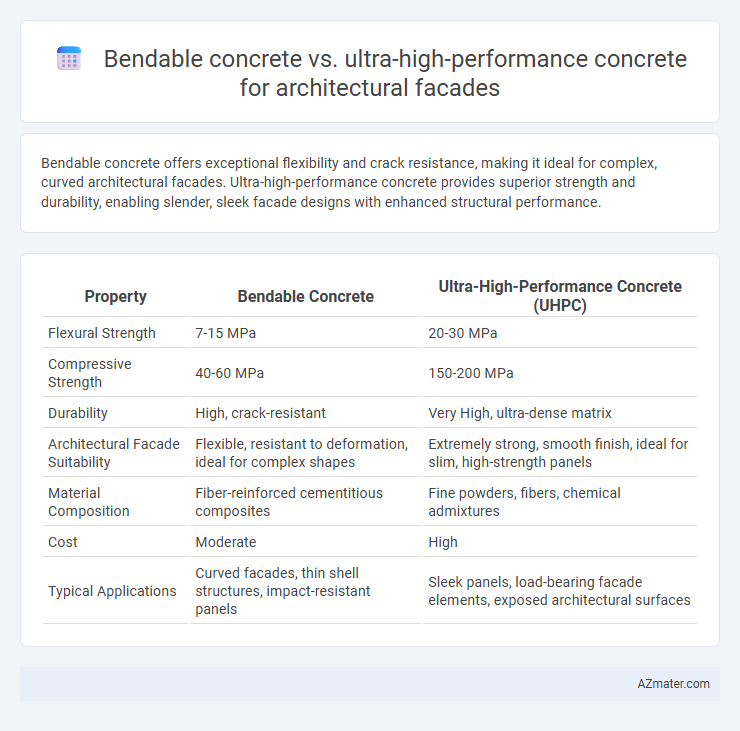Bendable concrete offers exceptional flexibility and crack resistance, making it ideal for complex, curved architectural facades. Ultra-high-performance concrete provides superior strength and durability, enabling slender, sleek facade designs with enhanced structural performance.
Table of Comparison
| Property | Bendable Concrete | Ultra-High-Performance Concrete (UHPC) |
|---|---|---|
| Flexural Strength | 7-15 MPa | 20-30 MPa |
| Compressive Strength | 40-60 MPa | 150-200 MPa |
| Durability | High, crack-resistant | Very High, ultra-dense matrix |
| Architectural Facade Suitability | Flexible, resistant to deformation, ideal for complex shapes | Extremely strong, smooth finish, ideal for slim, high-strength panels |
| Material Composition | Fiber-reinforced cementitious composites | Fine powders, fibers, chemical admixtures |
| Cost | Moderate | High |
| Typical Applications | Curved facades, thin shell structures, impact-resistant panels | Sleek panels, load-bearing facade elements, exposed architectural surfaces |
Introduction to Architectural Façade Materials
Architectural facade materials play a crucial role in both aesthetic appeal and structural performance, with bendable concrete and ultra-high-performance concrete (UHPC) emerging as innovative options. Bendable concrete offers enhanced flexibility and crack resistance, ideal for complex, curved facade designs requiring durability and lightweight properties. UHPC provides exceptional strength, durability, and smooth finish, making it suitable for sleek, high-performance facades with minimal maintenance and superior weather resistance.
Understanding Bendable Concrete: Properties and Applications
Bendable concrete, characterized by its high ductility and tensile strength, offers enhanced crack resistance and flexibility compared to traditional concrete, making it ideal for complex architectural facades that require curvature or deformation without compromising structural integrity. Its fiber-reinforced matrix allows facades to withstand dynamic loads and seismic activity better than ultra-high-performance concrete (UHPC), which, while exhibiting superior compressive strength and durability, is more rigid and suited for flat, load-bearing surfaces. Applications of bendable concrete in architectural facades include adaptive shading systems and intricate geometric patterns, where elasticity and resilience to environmental stress are paramount.
What is Ultra-High-Performance Concrete (UHPC)?
Ultra-High-Performance Concrete (UHPC) is an advanced cementitious material characterized by exceptional compressive strength exceeding 150 MPa, enhanced durability, and superior tensile properties due to its dense microstructure and fiber reinforcement. Its ultra-low permeability and resistance to environmental degradation make UHPC ideal for architectural facades requiring both aesthetic versatility and long-lasting performance. Compared to bendable concrete, UHPC offers higher structural capacity but less flexibility, influencing design choices in facade applications where load-bearing and resilience are critical.
Mechanical Performance Comparison: Strength and Flexibility
Bendable concrete offers exceptional flexibility with tensile strain capacity up to 0.7%, making it ideal for architectural facades requiring deformation without cracking. Ultra-high-performance concrete (UHPC) provides superior compressive strength exceeding 150 MPa, ensuring high durability but limited flexibility with tensile strain typically below 0.1%. The mechanical performance comparison highlights bendable concrete's advantage in flexibility for dynamic facades, while UHPC excels in strength and resilience against mechanical loads.
Durability and Weather Resistance in Façade Applications
Bendable concrete offers superior crack resistance and flexibility, making it ideal for facades exposed to dynamic loads and temperature fluctuations, enhancing long-term durability. Ultra-high-performance concrete (UHPC) provides exceptional compressive strength and dense microstructure, significantly improving weather resistance against freeze-thaw cycles, moisture intrusion, and chemical attack. Both materials extend facade lifespan but UHPC excels in harsh climatic conditions, while bendable concrete is preferable where bending stress and crack control are critical.
Design Versatility and Aesthetic Potential
Bendable concrete offers exceptional design versatility with its ability to form complex, curved shapes and thin sections, enabling innovative and lightweight architectural facades. Ultra-high-performance concrete (UHPC) provides superior aesthetic potential through its ultra-smooth surface finish, enhanced durability, and capacity for intricate detailing, ideal for sleek, modern facades. Both materials allow architects to push creative boundaries, but bendable concrete excels in dynamic forms while UHPC emphasizes refined textures and longevity.
Sustainability and Environmental Impact
Bendable concrete, known for its enhanced tensile strength and flexibility, reduces cracking and maintenance needs, thereby extending the lifespan of architectural facades and lowering material consumption. Ultra-high-performance concrete (UHPC) offers superior durability and compressive strength, allowing thinner sections and less frequent repairs, which contribute to reduced embodied carbon over time. Both materials promote sustainability by optimizing resource efficiency and enhancing facade longevity, but bendable concrete excels in minimizing waste through its crack-resistant properties, while UHPC's dense microstructure improves resistance to environmental degradation.
Installation Methods and Construction Challenges
Bendable concrete offers flexibility by integrating microfibers and engineered cementitious composites, enabling curved and intricate architectural facades with simplified formwork and minimal cracking during installation. Ultra-high-performance concrete (UHPC) requires precise mixing, casting, and curing methods, often demanding specialized labor and equipment due to its dense matrix and low water-cement ratio, posing challenges in on-site application and scalability. While bendable concrete reduces installation complexity through enhanced ductility, UHPC demands stringent quality control to overcome construction challenges, balancing durability with increased labor and logistical requirements.
Cost Analysis: Material and Lifecycle Expenses
Bendable concrete offers cost advantages in initial material expenses due to its reduced crack repair and maintenance needs, making it economically favorable for long-term facade applications. Ultra-high-performance concrete (UHPC) incurs higher upfront costs driven by its specialized constituents like fine powders and fibers but provides enhanced durability and resistance to environmental degradation, potentially lowering lifecycle repair costs. Analyzing total cost of ownership reveals bendable concrete as more budget-friendly for projects prioritizing flexibility, while UHPC suits facades demanding superior strength and longevity despite higher initial expenditures.
Choosing the Ideal Concrete for Architectural Façades
Bendable concrete offers superior flexibility and crack resistance, making it ideal for complex, curved architectural facades that require lightweight and durable materials. Ultra-high-performance concrete (UHPC) provides exceptional strength, density, and longevity, suited for sleek, modern facades demanding minimal maintenance and high structural integrity. Selecting between bendable concrete and UHPC depends on design complexity, desired aesthetic, and performance requirements, with bendable concrete excelling in adaptability and UHPC in durability and strength.

Infographic: Bendable concrete vs Ultra-high-performance concrete for Architectural façade
 azmater.com
azmater.com